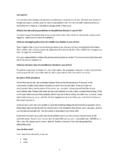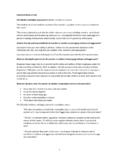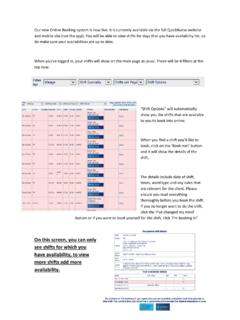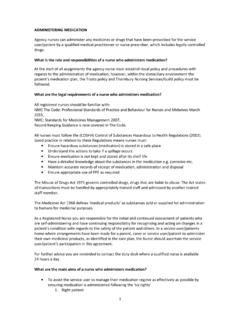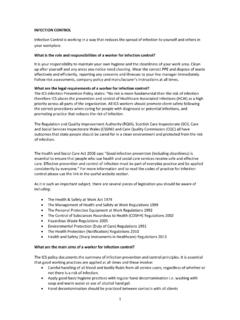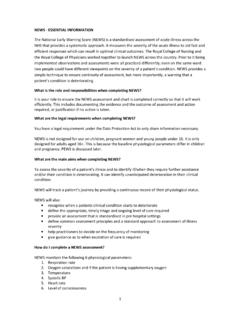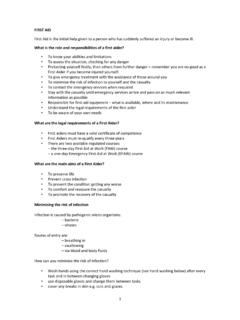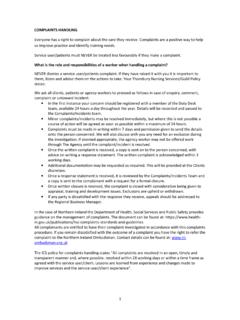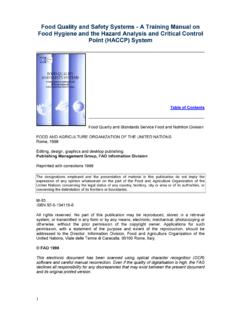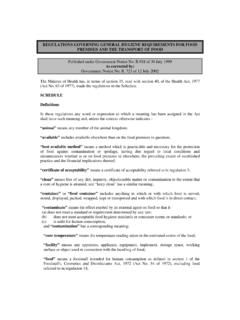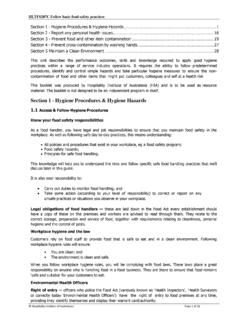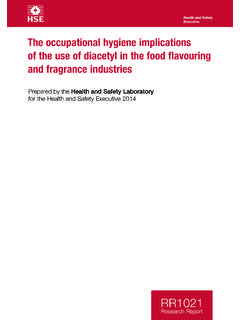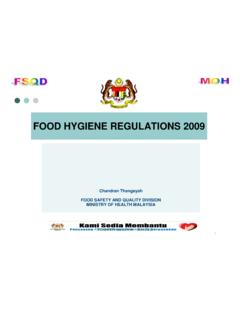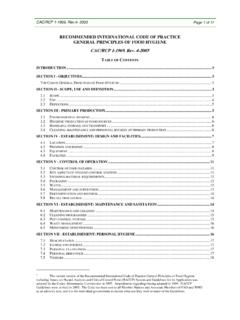Transcription of FOOD HYGIENE What is the role and responsibilities of a ...
1 1 food HYGIENE Correctly storing, handling and preparing food is essential to the health of the service user/patient. food preparation areas must be kept clean and hygienic at all times to avoid the spread of infection and bacteria. food contamination is usually caused by bacteria, however, it can also be caused by viruses or parasites. What is the role and responsibilities of a worker who prepares food and drink? The role is to understand and practice safe food handling and preparation techniques in order to keep the service user/patients and yourself safe from harm at all times. If you have any questions or concerns you must seek further advice and possibly training. What are the legal requirements of a worker who prepares food and drink?
2 Every workplace should have a clear policy for food HYGIENE . The ICS policy documents the summary of infection prevention and control principles. It is essential that good working practices are applied at all times and these involve: Careful handling of all blood and bodily fluids from all service users, regardless of whether or not there is a risk of infection. Apply good basic HYGIENE practices with regular hand decontamination washing with soap and warm water or use of alcohol hand gel. Hand decontamination should be practiced between contracts with all clients Cover existing wounds or skin lesions with waterproof dressings. Wear appropriate protective clothing, disposable gloves and plastic aprons must be worn when in contact with blood and bodily fluids.
3 Protect the mucous membranes of the eyes, nose and mouth from blood splashes. Treat all blood or bodily fluids as potentially infectious. Clean and disinfect all blood spillages immediately with detergent available in the client s home. Do not re-sheath or recap needles they must be placed directly into an approved sharps container preferably by the user. Hazardous or infectious waste must be disposed of according to the waste management section in the ICS Health and Safety policy. If the ICS worker has had symptoms of gastroenteritis he/she must consult their GP and must not return to work until symptom free for 48 hours. Inform the line manager/appropriate other. Report any illness such as diarrhea, vomiting, chicken pox, shingles or flu to the line manager/appropriate other.
4 Adhere to the food HYGIENE policy and ensure that all food prepared in service user/patient s homes for service user/patients is prepared, cooked, stored and presented in accordance with the high standards required by the food Safety Act 1990, the food Safety (General food HYGIENE ) Regulations 1995 and the food Safety (Temperature Control) Regulations 1995. Any Agency worker who becomes ill while handling food should report at once to the manager/supervisor at the place of work, or to The Agency office. Agency workers involved in food handling who are ill should see their GP and should only return to work when their GP states that they are safe to do so. Non-clinical waste should be disposed of in normal black plastic bags. The Social Care Institute for Excellence (SCIE) website have defined the food Safety Act 1990, food Safety (General food HYGIENE ) Regulations 1995 and food Safety (Temperature Control) Regulations 1995 as: The food Safety Act covers the preparation, storage and service of food and requires the 2 registration of food businesses whether they are run for profit or not.
5 A ' food business' includes canteens, clubs and care homes. The CQC requires that care services ensure that the food and drink they provide is handled, stored, prepared and delivered in a way that meets the requirements of the Act. The local authority is responsible for enforcement through environmental health and Trading Standards. The food Standards Agency (FSA) can intervene where local authorities fail to meet the requirements and in emergency situations. What are the main aims of a worker who prepares food and drink? The main aims are to prevent the spread of infection and bacteria that could cause food related illnesses to the Service user/patients and to keep work areas clean and safe at all times. Consequences of poor food HYGIENE Poor food HYGIENE can cause anything from stomach upsets, severe vomiting and diarrhoea to even death in some circumstances.
6 At risk groups The very young, pregnant mothers, those who are already ill and the elderly and infirm at most at risk. However, these groups may be a higher risk, but ultimately anyone can get food related illnesses if good practice is not followed at all times. Bacteria Bacteria are tiny organisms, not all bacteria are harmful to humans but some cause infections. Raw foods including meat, poultry, fish, shellfish, eggs, dairy products and fresh produce often contain bacteria when they are purchased, this bacteria can make it harmful to eat. Foods may also be contaminated with bacteria during food preparation. It is important that hands are thoroughly washed, kitchen utensils, surfaces, chopping boards and all surfaces that come into contact with food are clean.
7 Otherwise the spread of bacteria from contaminated food to uncontaminated food may occur (cross-contamination). Bacteria multiply quickly when the temperature of food is between 5 and 63 degrees centigrade. At room temperature, bacteria in food can double every 20 minutes. The more bacteria there are, the greater the chance you could become sick. Cold food should be kept below 5 degrees and hot food should be kept above 63 degrees. When food is refrigerated bacteria do not die, but they do stop multiplying, they will start to multiply again once they reach 5 degrees. Cooking food at over 63 degrees for 2 minutes or more kills the bacteria. Minimising the risk of infection Follow the good hand washing guide you learnt about in the Infection Control module.
8 It is repeated in the further information section of this module if you need to revisit it. 3 Personal HYGIENE Good personal HYGIENE is important when preparing food as bacteria live on your skin and can easily contaminate food . You should shower/bathe every day and avoid using strong smelling perfumes/deodorants/after shaves that can also contaminate the food and alter its flavour. Hair should be tied back and/or covered. If you touch your face or hair at anytime you must wash your hands straight away. food premises food premises should be easy to clean, have plenty of adequate storage and lighting. All areas should be clutter free to avoid the buildup of dust and other contaminants. Always make sure the area and the utensils are clean before you start to prepare food .
9 Stainless steel worktops and utensils are preferable than wood as they are easier to clean and more hygienic. Assisting and serving food If you are serving or assisting a service user/patient with their food always wash your hands and wear blue gloves and apron. Blue is so that if any part of the glove or apron become detached it can clearly be seen in the food . It is important that you do not handle the food unless absolutely necessary and for the shortest amount of time possible, without rushing the service user/patient. Never leave food lying around, always serve and assist as soon as it is the right temperature for the service user/patient. Remember food can only be reheated once, never reheat again! Always gain the service user/patients consent before you assist them with their food .
10 Always handle mugs and cups by the handle and never handle glasses by the neck where the service user/patient will drink from. If you are making food in the community it is important that you label the food when you have opened it, if you are not using it all. For example if you open a tin of baked beans and use half for the service user/patients lunch the rest should be put in a sealable container and labeled with content and date opened. Managing waste Bins in a kitchen should be foot operated so that you do not have to touch the bin. If you do touch the bin wash your hands immediately. Never let the waste bins overflow; always empty them when they are at a maximum of 75% full. Outside bins must not overflow, if there is not enough room for the waste this must be reported immediately as overflowing waste can attract pests and vermin causing a health hazard.
